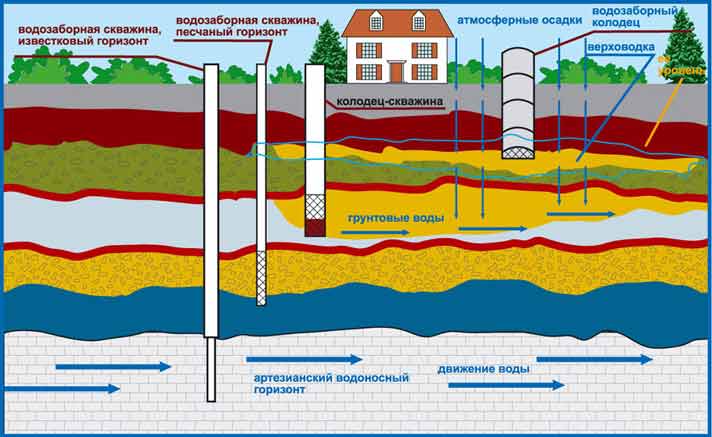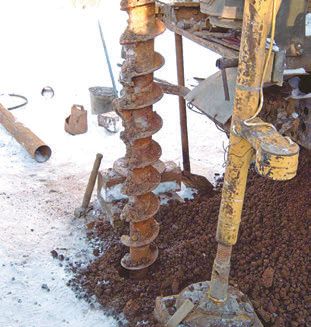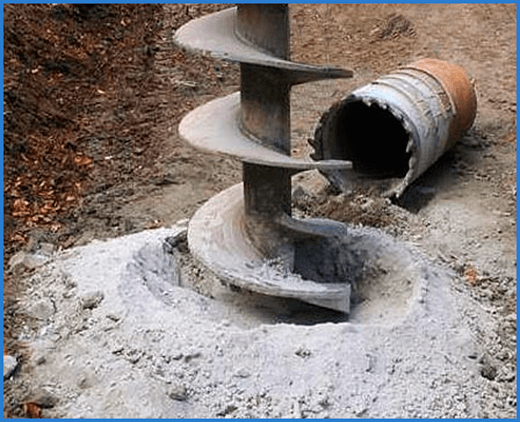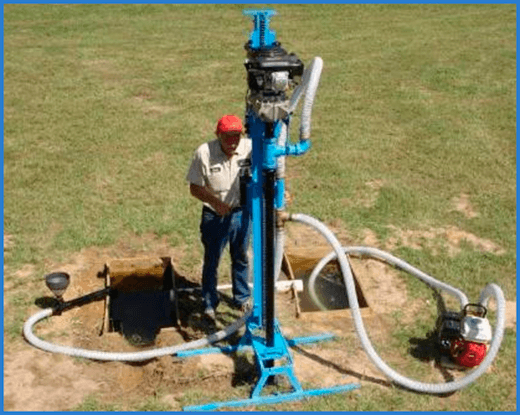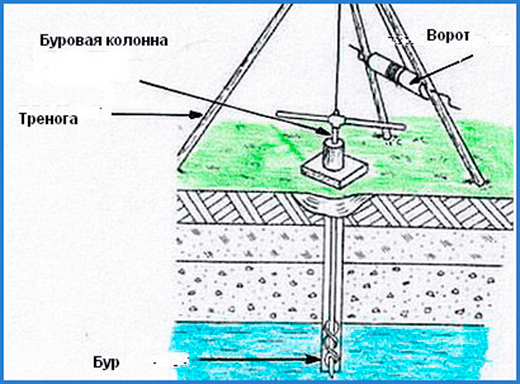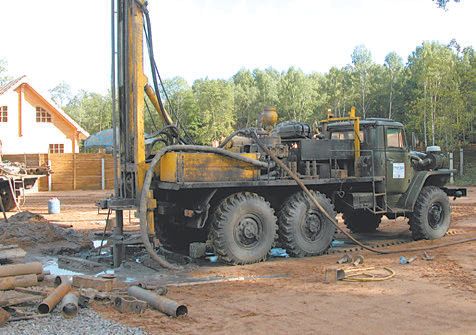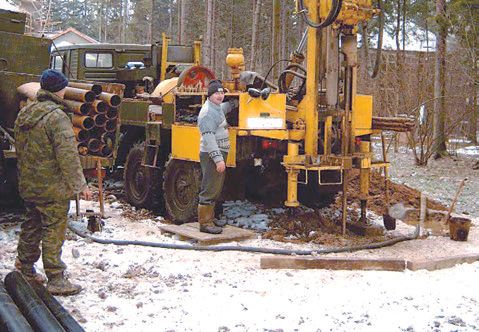Types of wells
Drilling a well in the country is not so difficult. Its price will depend on the depth of the water. A sand well will be much cheaper than an artesian well, and this should also be taken into account.
Well on the sand
Done to a great depth. Therefore, it is quite possible to do all the work with your own hands and this will significantly reduce the cost of your venture. Before starting work, you should find out what quality the water is at a shallow depth. To do this, it is best to take a sample from the neighbors and take it for examination and check the quality. We will give the parameters below.
Suitable for the place where you live permanently. This water is of better quality. But the work will cost more. Here it would be better to hire a specialized organization. And immediately it will be necessary to provide for its cleaning. It is located in lime layers and therefore has a high iron content. Immediately provide for proper filtering.
Attention: If you do not live permanently in the country and you only need water for irrigation, then you can safely make such a design
Determining the quality of water
Water in a well or well is considered drinking water in the following cases:
- When the water is clear thirty centimeters deep;
- When nitrate impurities do not exceed 10 mg/l;
- When one liter of water contains no more than 10 Escherichia coli;
- When the taste and smell on a five-point scale, water is estimated at least three points.
To determine these indicators, water must be subjected to laboratory analysis in the sanitary and epidemic service.
How to drill a well
Let's analyze this process from a theoretical point of view:
- Work begins with digging a hole, whose depth and diameter must be at least two meters, or a side of one and a half meters. This measure prevents further shedding of the soil of the upper layer.
- The pit is strengthened with plank shields. Further, with the help of a column and a drilling rig, a well is drilled. The drill column is suspended on a tower at the central point of the future well.
- The drill string consists of several rods, which, with the help of adapter sleeves, are lengthened during the drilling process. The drill head is mounted at the end of the column.
- The tower is mounted from logs, steel pipes, a channel or a corner, which are made into a tripod, at the top of which a winch is attached.
Attention: If the water is shallow, drilling can be done without a tower. In this case, they use special shortened rods one and a half meters long.
If you cannot do without a tower during drilling, the length of the rods in this case should be at least three meters.
What to drill
The equipment and method of drilling is selected based on the type of soil. The tool used must be made of carbon steel.

We select tools and materials
Drilling is carried out using the following drill heads:
- For drilling in clay soils, a drill is used in the form of a spiral with a base of 45-85 mm and a blade 258-290 mm long.
- In percussion drilling, a drill bit is used. The drill can have a flat, cruciform and other shapes.
- Drilling in loam, sandy clay or clayey sand is carried out using a spoon drill made in the form of a spoon and having a spiral or longitudinal slot. This drill has a diameter of 70-200 mm and a length of 700 mm and deepens for a passage of 30-40 cm.
- Extraction of loose soil is carried out with the help of a drill-bailer using the impact method. The bailers are made from a three-meter pipe and have a piston and ordinary appearance. Inside the bailer should have a diameter of 25-96 mm, outside 95-219 mm, its weight should be 89-225 kg.
Drilling is a cyclic process, periodically accompanied by cleaning of the drilling tool from the soil.Cleaning is carried out with the complete extraction of the drill from the soil. Accordingly, the difficulty of extracting them from the well depends on the length of the hose.
How to drill a well for water of various depths
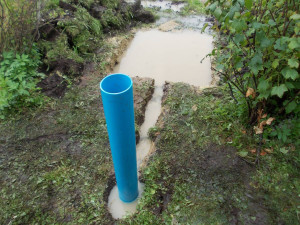
There are two ways out of the situation - a centralized water supply or an individual source. But since land holdings are often distant from each other, the first option is not a cheap pleasure. So the summer resident has to drill a well for water himself. This is not an easy task, since much in this matter depends on the type of well device and, of course, the special drilling technology.
When to drill a well
Those readers who, for some reason, did not have time to acquire their own water source in the country in the fall, or they are not satisfied with the existing water source, and they decided to arrange a water source now.
The right decision: a reasonable owner thinks about this not on May 1, but on March 1. However, it is worth noting that the most successful time for drilling a well is the time after the end of the season (October, November, even December). March is also a good period: in frost on hard ground, it is much easier to drive 15-ton vehicles to the site than in warm weather on soft ground. Although drilling a well when it is warm is easier for both equipment and people. Now the snow will begin to melt, and it will become more and more difficult to drill a well: even three-axle drilling machines get stuck in the snow, and when they start digging the ground, they generally “sit down”.
Among other things, you need to know that some dacha villages, cottages, where the shareholders themselves laid roads on their own, simply close the entrance to any equipment, except for personal vehicles. Persuade do not persuade, threaten, pay - it's useless. A decision was made by the general meeting - no drilling rig will enter there. In this case, you will have to wait for the end of the flood, and maybe even until the end of May.
And another very important point when drilling a well. The price of drilling a well is not constant within the annual cycle. Pipe complexes roll pipes all the time, in summer there is demand, in winter there is no demand. Therefore, the price of pipe products in summer is higher. Serious companies that bought pipes before the new year for all their profits can drill for some time using cheaper pipes. The dynamics of prices for fuel and lubricants also affects the overall cost. A good well takes up to one and a half to two tons of gasoline. The lowest prices for drilling are from mid-October to March. At the end of March, they begin to grow. For example, for the arrangement of an artesian well, if we talk about the region of the Moscow region, you can order drilling a well for water here.
A shallow well in the sand is usually drilled for one light day. A deep well is drilled from two to five days. If you have a drilling rig and have been drilling a well for two weeks, you can immediately drive it. Artesian wells, in principle, no matter when to drill, these wells cannot be dug during a flood, it is clear why (they will be shallow with water, and then the water will run out). Wells on sandy horizons too.
For many years I have not been convinced that they are somehow actively seasonally filled with water. If the horizon is normal, it never dries up in summer. Just do not confuse perched water and ground horizons. Verkhovodka is a seasonal aquifer that occurs after snowmelt and stays at the top for some time, and then goes down. And the well is built on a permanent reservoir that never dries up.
Drill auger while drilling a well on a sandy aquifer
Various well options
Before proceeding to drilling, it is necessary to figure out what the depth of the water source is, and, having this information, decide which type of well is most suitable. It depends on which work plan you should choose.Really distinguish the following types:
- Abyssinian well (aquifer at a depth of 3-12 m);
- well "on the sand" (not deeper than 50 m);
- well "on limestone" (artesian - up to 200 m).
The first two types will not cause much difficulty compared to the last, since such a large depth will require a drilling rig and professional workers.
Which well to choose? It all depends on the required amount of water consumed. If a small flow rate is required, then the first two options are chosen, and if you need from 10 cubic meters of water per hour, then an artesian type is arranged.
Features of different types
You should start with the Abyssinian well. Since the depth here is not very large (3-12 m), it is necessary to take into account the location. Care must be taken to place the well as far away from potential dirt accumulation areas as possible. That is, there should not be garbage pits, compost nearby, which can pollute the water and make it unusable. There are times when hard rocks or pebbles are absent in this area, then there is only one way out - to drill a source right in the basement of the house. But here a number of problems may arise, since it will be necessary to equip the well with manual columns and a pump in order to be able to extract liquid without unnecessary energy costs.
As noted above, a sand well can be cut to a depth of no more than 50 meters. Before you start drilling, you need to draw up a plan, that is, choose a suitable place. The well should be as far as possible from various sources of pollution. Even a bathhouse or a poultry farm fall under this concept. It is also necessary to take into account future buildings, since it will be almost impossible to move the source.
Getting started how to cut a conventional well
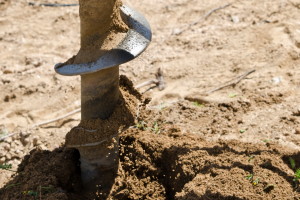
Mark up for future work.
Dig a hole for a tool (auger, drill).
Install drilling tools.
Carry out drilling according to the chosen technique.
Lower the column for the filter into the hole. It consists of a filter, a sump and a pipe.
Fill the distance between the outer walls of the casing pipe and the soil with sand or gravel.
Seal the top of the pipe and pump water into it so that the filter is washed.
Pump out the liquid from the well using a column or screw pump.
Lower the submersible pump into the well. To do this, apply the force of a safety rope
It is important to remember that these actions can be done when the water has already become clean.
Connect the hose (water pipe) and the pump.
Install a valve on the pipe so that in the future you can adjust the liquid level.
Waterproof the top of the casing.
Treat the wellhead with a caisson and weld it to the head.
Lay the water pipes that lead to the house in the trenches intended for them.
Sprinkle the caisson and concrete pavement with soil.
Such a source will last no more than 10-15 years. But it is necessary to periodically check the well to control the purity of the fluid.
How to drill an artesian well
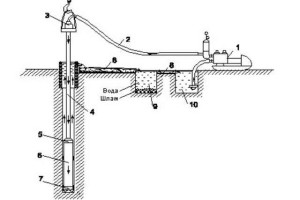
- a drill, the components of which are a core barrel, a drill rod, a core for drilling, an active part;
- metal screw;
- tripod;
- winch;
- several pipes with different diameters;
- valve;
- caisson;
- filters;
- pump.
It is not necessary to buy all these tools, because they can cost a fortune. It is advisable to rent them. The work proceeds according to the following algorithm:
- Dig a 1.5 m x 1.5 m hole. Line it with plywood and boards so that it does not crumble.
- Install a sturdy derrick, preferably made of metal or wood, directly over the recess. Then fix the winch at the junction of the supports. This device is used for lifting and lowering equipment.
- Choose the right pump that will fit easily into the pipe.
- Lower the filter column, which consists of a pipe, a sump and a filter. But it is worth doing this when the required depth has already been reached. In order to strengthen the pipe, the space near it is covered with sand. In parallel with this, pump water into the pipe, the upper end of which is airtight.
Next, simply lower the pump, and then a hose or water pipe is needed to bring water out of the depths. Connect them too. To do this, remove the pipe and weld it to the head of the caisson. Next, install a valve that will regulate the level of water inflow - and your well is ready.
Drilling
The easiest way is auger, using a drill. For shallow wells, the use of a derrick is not required. The whole process is carried out by two or three people, since a lot of force must be applied when the drill rotates.
Before starting work, you need to dig a small hole. This will give the drill direction and help it cut into the ground. The first turns can be done alone, but then you need an assistant. As soon as the drill is deepened to its full length, it is carefully pulled out and cleaned of the ground.
During drilling, it will have to be constantly removed and cleaned. As necessary, the length of the drill is increased by additional rods.
You need to drill until water appears. The hint will be the appearance of wet earth. However, you should not immediately stop working, usually the first layer of water is ground. It is necessary to drill to the water-resistant layer, which will ensure a good flow of water.
After you get to the aquifer, you need to pump out dirty water with a pump. Having pumped out 40 - 50 liters, the well will be cleaned. If the water is still dirty, you can still go deeper a couple of meters.
Device
At the end of drilling, the well must be equipped. For its arrangement, casing pipes should be used - asbestos or plastic.
For reliable fastening, pipes must have landing rings. After installation, they are covered with expanded clay or gravel.
Underwater well - drilling methods
The screw method is the easiest and cheapest way. Based on the use of a screw (screw). The disadvantage of this method is that drilling is possible only in soft and dry soil.
Rotary - produced by a drilling pile, inside which a special shaft with a chisel rotates. The crushed soil is removed by leaching.
Shock-rope drilling method is the slowest and most labor-intensive. However, it is considered the highest quality. The service life will be more than 50 years. The well in this case is made using a heavy projectile for crushing the rock. Among the shortcomings can be noted - the high price of work.
In conclusion, it is worth noting that drilling is best left to professionals. A drilling error can lead to equipment failure or contamination of the well itself. However, if you have the necessary knowledge and if you have the equipment, then you can make a well with your own hands.
Watch the video: Do-it-yourself well drilling in 2 days
What you need to pay special attention to when drilling a well
In the contract, the conditions for accepting work should be clearly spelled out: the quality of water, the amount of water and the depth of the well are checked. The customer is required to demonstrate the water flowing from the well. Its amount is easy to measure with a bucket and a stopwatch on the clock. Water should be visually transparent. Some turbidity is acceptable in it, but there should not be more than one tablespoon of sand, grains of sand, say, for a bottle of water.
The well is measured to the bottom. The customer must necessarily accept the depth of the well on site.There are different ways: a weight on a string marked by a meter; drilling rods, etc. Unscrupulous teams offer the following: “We drill 20 meters, we will write for the company that 15, and you pay us 5 at a different rate.” Therefore, serious companies prescribe in the contract that if the indicated depth of the well does not correspond to the actual one, no guarantees are provided to the customer.
Drilling a well with the URB 2A2 rig
It happens that a well is drilled, but there is no water. There are two options here: it simply does not exist, or the drillers could not get it for some reason. It turned out, the so-called - dry well. Normal companies always warn that there is a danger of getting "rusk" when the customer did not find out anything, did not interview the neighbors.
Wells are not wells, there will always be water in the wells, they work due to the wide bottom, a small layer of sand is enough - there will be water. The well works with side walls, a filter, and not half a meter of sand is needed, but 5-7 meters for the well to start working. Such a layer of sand may not be on the site. For example, on 50% of the territory of the Moscow region, sands occur in patches. There is a lens of sand here, and then it ends, and it is not outwardly marked in any way.
How to deal with it? Work more clearly with neighbors, find out, look for a good geologist, raise catalogs, maps. Or drilling a well for artesian water, which is everywhere.
If the brigade failed. The reasons may be difficult drilling conditions (boulders, large clastic material, crushed stone, gravel), but more often it is a bad drilling tool, worn-out equipment, and an inexperienced master. How to deal with it? Do not try to save money by all means, but contact a serious company.
Location selection
The well is a capital structure, and the choice of the place where it will be located should be approached with special care. There are several nuances that should be considered when it is located. After all, the quality of the water will depend on its location.
- The place must be accessible so that in the event of a repair, it is possible to freely approach the well or adjust the equipment.
- It must be protected from contamination, and comply with all sanitary standards.
- Before starting work, it is necessary to make sure that there is a close location of underground water sources.
- The well should be located no closer than 4 m from the foundation of the house and at a distance of 20 meters from the septic tank.
Tools
In order to acquire a well in your area, you need such a tool as: a special auger with extension knees. Files sharpened along the edges can be welded onto its edges. This addition will improve the performance of the factory drill.
Video: How to drill a well manually
In addition, you will need:
- casing pipes (asbestos-cement or plastic);
- hoses;
- shovel;
- cart for soil removal;
- drilling rig.
Where to drill a well
A drilled well is not transferred anywhere - it is not a house, not a garage, not a tent, not a barbecue. There are three unshakable rules for choosing a well drilling site.
First. To make it convenient for drillers to work. There should be a flat or slightly inclined area approximately 4 by 8-10 meters of rectangular shape, on which a three-axle machine is placed, above which there are no wires (the mast rises 8 meters up), under which there are no communications and which is from buildings, building foundations, tree roots, fence removed by 3 - 4 meters.
Second rule. To make it convenient to use the well. It should be drilled as close as possible to the place of water consumption (to the boiler room, bathhouse, kitchen), so that you do not have to dig many meters of stupid trenches throughout the site.
And the third rule. So that the well is drilled in a place suitable for the arrival of equipment on it again for repair work within the warranty period.Any well repair (to deepen, re-casing, flush, pick up fallen objects) is carried out only by a drilling machine, there is nothing to do with your hands. If such an entrance is impossible, no company will be able to fulfill guarantees. If the well is in a caisson, in order for the machine to lower the drilling tool through the caisson, the well cover and wells must be on the same axis.
Working platform when drilling with the URB 2A2 rig
